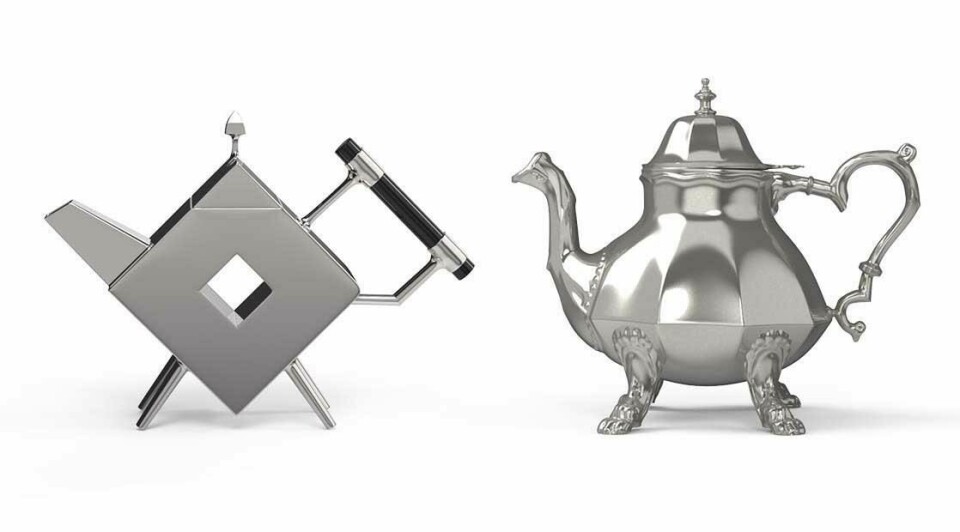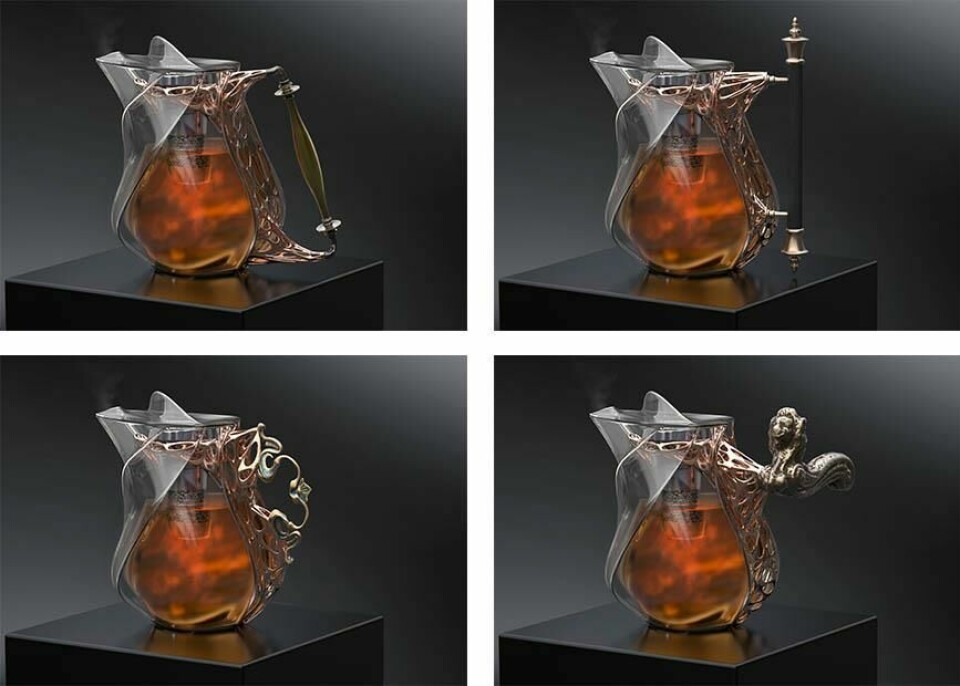
Reinventing Luxury with Chris Bangle
At the recent Pratt Institute Design Symposium 2021 on Re-Inventing Luxury held at the Whitney Museum in New York City, car designer and thinker Chris Bangle shared his thoughts on creating a new narrative around luxury design
The following text is a transcript of designer Chris Bangle’s talk at Pratt Institute Design Symposium 2021 on Re-Inventing Luxury held at the Whitney Museum in New York City.
Most people know me as a car designer, but teapots are objects just as automobiles are, and objects are the biggest branch of design within luxury. Teapots, cars, to me car design is about creating personality and this little teapot exudes character: it’s dying to tell me all about why I should want it, besides making tea. Its designer didn’t just give it a function, he infused it with meaning, and that’s what we designers do, we provide meaning by “controlling your minds”.
What part do we control? The part that says: “I like! I want!” Heck, we can convince you of anything – like 10,000 years of “More is More” should really be “Less is more”. We control the narrative – everything about design is a narrative––even the shapes and materials––not just the backstory about how it was made. You’ve heard the term “visual narrative”? If you’ve ever described something as looking “dynamic”, or “aggressive”, or even “confused”––you are extracting meaning from the visual narrative; how it looks is how it talks to you.
Design aligns the object’s narrative with the much bigger narrative of the Zeitgeist or whatever you want to call the external factors making up all that influences us. If we get them to align, we really can get you to do what we want: think ‘appropriate’ or ‘outstanding’ or ‘good taste’. Even ‘timeless’ is an alignment with a bigger meta-narrative.
The customer brings their own narrative to the party, but if we’ve done our job right and the other two are aligned, they will come on board. (There was a time—before luxury designers got a hold of them—when jeans were just jeans, remember? And SUVs were blue collar workhorses, not a Rolls-Royce or Bentley branded luxo-truck?).
Sometimes we pick parts of the narrative––“oh that has niche appeal” —but you can’t escape the glare of the meta narrative and when it gets really uncomfortable… you probably begin thinking it’s time to “re-invent” something. If this meta-narrative jargon sounds too abstract, it helps to look at something tangible.
Which is why this teapot is important to me: it’s an excellent example of a designer foreshadowing a narrative. It was created by the British designer Christopher Dresser. I think it’s wonderful in its stark geometric boldness, its ‘Machine Aesthetic’, the style of ‘Art Deco’ or that early Bauhaus look from the post-World-War-One art and design movements. Except it isn’t.
This teapot was designed in 1879, and this is what most luxury teapots looked like in 1879. If you had been in the audience then and I – as Dresser – had pulled out this teapot and proclaimed: “You will learn not to just like this sort of design, you will worship it;” you probably would have done more than your share of headshaking. Talk about ahead of his time! How did Dresser do this? After all, he studied botany and all his early works had plant motifs.

BUT! Before he designed it, the US Government commissioned him to report on the design of household goods and he was sent to Japan as a special envoy by the British to study their arts and crafts; two experiences that gave him a perch atop the 19th century design world––and from there he knew which way the wind was blowing.
Put another way: by 1879 the relentless drive towards rational perfection that had begun in the Age of Enlightenment was now finally ready to express itself in consumer design. Dresser saw the future belonged to the machine, with its tight tolerances and perfect surfaces. Though his teapot was masterfully crafted by a human, it does its best to hide this fact; almost like an inconvenient truth. Dresser designs are still manufactured, because the aesthetic values he foresaw more than a century earlier still hold true today: the immaculate is virtuous, human quality is inferior to machine quality.
Luxury based on material excess was always dependent on the masses not knowing enough to care. Those days are over
His teapot has been around 140 years, but the narrative it was designed for isn’t going to be ours for long now. The match of meaning to Zeitgeist is shifting… it’s time for a new teapot. The logic that Dresser foresaw of “machine perfection equals virtuous”, and by extrapolation that “the fallibility of man is a liability” became the new meta-narrative. If you fast forward this 100 years, you find it has controlled the minds of designers until it’s turned us into less than human: we have become in-humane. In order to create products that display virtue through uncompromising finish and material quality, Design has created a narrative for itself—that of uncompromising “Stronzo” ‘Star Designers” – who terrorize their studios in the name of perfection.
And at the same time, we’ve taught the consumer to be intolerant to anything that appears less than “perfection” when judging quality. Now to be fair, luxury is always the best of the best, but the times of conflating the meaning of “Best” with the aesthetic-narrative that Dresser predicted are ending. Why am I telling you this? Because there is another meta-narrative breathing down our necks! Let’s get biblical for a moment. You know the idea of Original Sin, right? In the Christian doctrine, it means that we are born in a debt condition, and that all believers must redeem themselves through their faith and their works.

Now that WE are in charge of Paradise – fully in the Anthropocene era—Original Sin is redefined in existential terms. “Original sin 2.0” Original Sin 2.0 is the debt of just having been born — and of the need to redeem your existence to everyone and everything on the planet. This will be the foundational meta-narrative from here on out, and if you don’t see it in the mirror, it’s ‘cause you’re not looking.
True redemption means accountability, and Original Sin 2.0 is going to have accountability teeth because everything can and will be knowable. In a future where everything is trackable, luxury can no longer cloak itself in general ignorance. Technologies that permit us to define the ownership of a jpeg via Blockchain can turn anything you want to hide into our own personal Dieselgate.
We used to talk about blood diamonds––how about blood aluminium, blood plastic, or blood kilowatts? Luxury will be – like everything else, under the Inquisition of the times to answer: “You, little teapot, what is it about you that made your maker and user a better planet citizen?” Luxury – based as it is on fundamental concepts of “not needed” and “excessive” and “exclusive” has only one real coin to offer in exchange: that of human engagement.
You don’t escape Original Sin 2.0 by adding another handful of craftsmen to make luxury goods and experiences real. We have those today; those wonderful artisans are all that is left of what was once a chain of people with a purpose. But you cannot maintain the fiction of human dignity when every link where a person could serve is dismantled by Design and replaced by Efficiency, Economy of Scale, or Machine-Made Perfection.
For designers, it’s either ‘help make it happen or get out of the way’; it is not just an inevitable change, it is inexorable
Luxury based on material excess was always dependent on the masses not knowing enough to care. Those days are over. Maybe to some of you that sounds dystopian, but I assure you that others believe it is the answer to the dystopian injustices we are in now. It’s a big challenge; Original Sin 2.0 is waaaay bigger than sustainability initiatives – but you don’t unf**k a planet by asking people to do what they did before but do it “eco-friendly”. But this is the deal: for Design – and the design of luxury as well, it’s gonna be great!
Why? Because we can escape from one cycle of design that is overly focused on “WHAT” we produce, and we can get back to doing what Design does best: Provide meaning by addressing the much better questions of WHY what we make is so important.
This quote from Alice Rawsthorn says it all: “…the most thrilling periods are the ones of the greatest change, when designers interpreted shifts in science, technology, behaviour and politics for the rest of us.” Believe me when I tell you, this WILL be the most thrilling period of Design! But you say, “Hey, Chris, ‘Economy of Scale looking Efficient Perfection’ designed products are what I like!” I understand; it’s not your fault and it is not your problem to fix. Consumers are not responsible to resolve this, Designers are. Remember, we control your minds?

For designers, it’s either ‘help make it happen or get out of the way’; it is not just an inevitable change, it is inexorable. There is a line being drawn between the past and the future, and everything we do – and get you the customer to do – has to be on the right side of it. All those sacred dogmas of design – all that “form follows function” and “less is more” and all those wonderful commandments handed down by Dieter Rams – they are wedded to our heritage of using machines to make what we like and therefore liking what machines make.
They’re going to have to answer to the Inquisitors, and they will be judged too exclusive, too static, too unresponsive, too inadequate, and too In-Human to deal with the shift in narrative of Original Sin 2.0. 5 I’ll go even further; just like today––if it doesn’t play by the rules of Capitalism, design doesn’t get made––in the future, everything of value will be witness to the human engagement, or it will not exist! If we want no inhumanity in Luxury, we need to start with no inhumanity in Design.
Nothing, not even the narrative of shapes is exempt. I fully imagine those building blocks of a Machine Aesthetic––the Platonic solids––will get the heave-ho. If we can for once admit that great civilizations with great artists and thinkers managed to do so well without having the cube, the cone, and the sphere to worship, then we can find what lies beyond them as well. We need to be humble enough to admit what we have created – A.I.– is better than us, but arrogantly confident enough to pick up the challenge of inventing a new design paradigm that is for us – one that doesn’t just enable users, it includes and empowers Humanity. How are we going to do this? I honestly don’t know, not by a long shot.
But we have been experimenting in the CBA studio and I want to end with a vision of what we found. We were asked by the German Government to take a Design look at Man-machine Coexistence— as in “What will people do in the future?” – and it pretty clear it’s not a question of man or machine, it’s a “best for us — together with machines” sort of formula we need to discover. We found that if A.I.-based computer programs can take a broken vase and work Kintsugi magic on the parts (fig. 3); it can also take real human contribution and make it fascinating.
Re-inventing luxury begins when we re-invent design. The line is drawn, the clock is ticking, the Inquisition is forming. It doesn’t have to be scary, but it will be the greatest creative challenge Design has ever responded to
Our brief was to see how Design can impact a world of machines and humans––lots of humans. If you understand that atoning for our collective Original Sin 2.0 means giving lots of people a Purpose everywhere in the world, then you have to employ them in groups of hundreds or thousands at a time—and that means in a clean factory—exactly where they are muscled out by robots and the like today.
But instead of competing with machines to put stuff together predictably and precisely, this time you pay them for doing what people do best––taking stuff 6 apart, so it can have a Second Existence (2E) – and replace recycling with a turbocharged version of up-spiralling – and let the machines fill in the blanks spots.
This way we do the planet some serious good by extending the life of what we make into new cycles of use, project upcycling miles beyond the mom-and-pop single instances it is today and bring recycling into a clean and protected space (where in much of the world it is definitely not today). In our vision the law would obligate products that only machines can put together to either put the people back in the loop – or buy credits that are earned by these 2E factories that are giving old parts a new life.
This puts the profits of tech to good work by jump-starting a whole new industry that is people-based. I come from the car business, and that is exactly how the obligation for Zero-Emission credits led to the transfer funds from the “old” car manufacturers into a start-up named Tesla; it will work here too.
We tried to make our own 2E teapot and I can tell you that for Design it will be a titanic shift of mind and eye. We will have to revel in the design of the In-Between – shift the focus from holism and derive a new aesthetic narrative from what was once revered for being invisible – the part lines—and imagine our designs being used again and again in new ways, even design the products from their second use case and work backwards towards a first.

If we designers are challenged, imagine what that signifies to what we are designing! To a product this is an existential question––“What is my “WHY”––my Purpose?” If, in the future, you ask the little teapot “Why are you here?” and it says “My Purpose is to be sold” that’s not good enough for Original Sin 2.0’s Inquisitors. Even if it says “To make my purchaser happy” that too is not good enough; that’s not the sort of re-invention of luxury that will begin to pay off our debt. The answer should always be, “Can’t you see? I’m part of something bigger than me, something wonderful for people you never met and who aren’t even born yet.”
To stop being mind-controlled into the in-humane, Design needs to share control of the narrative, and begin design processes with a heart to heart with the thing itself – a journey of discovery we call Objectomy. As we tried to apply Objectomy to our designs, we found it opened a magical door to design as we never saw it before. We discovered that when you earnestly listen to a teapot talk and let that guide your actions, it means you are not outside the narrative commanding it like a sculptor shapes clay.
Instead, you begin to design diegetically – inside the narrative. Then suddenly design processes become wonderful design adventures; Diegetic Design only works when you learn to let go and allow both your narratives – yours and the teapot’s – intertwine into something more than the sum of its parts.
All these ideas are counter-intuitive—designing in a free-fall of happenstance? Embrace impermanence? Celebrate the mis-fit of parts? Create factories just for people to take stuff apart? But every rebellious word, fantastical moment, implausible design – will be the rallying point for a harmony between narratives, redemption in the eyes of Original Sin 2.0.
Re-inventing luxury begins when we re-invent design. The line is drawn, the clock is ticking, the Inquisition is forming. It doesn’t have to be scary, but it will be the greatest creative challenge Design has ever responded to. I am convinced Design will succeed at redeeming itself; it will be thrilling, and it happens when we stop fussing over the “WHATs” we can create and move on the WHY of what we should––and will––create. Thank you.



